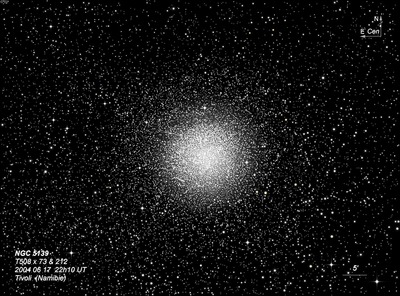Omega Centauri
Omega Centauri

10x30mm Canon IS (3/28/19 - Tasmania): very prominent naked-eye as Omega Centauri culminated within 5° of the zenith from this southern location. Huge in 10x30mm, though no resolution.
Ptolemy catalogued Omega Centauri = NGC 5139 = Lac I-5 = D 440 = h3504 as a star in the Almagest (150 AD). Edmond Halley discovered its nebulous nature telescopically in 1676-77 from the island of St. Helena. He included it in a short list of a half-dozen "luminous spots or patches" found while cataloguing southern stars. Nicolas-Louis de Lacaille reported "Naked eye, a 3rd mag star [10 Cen] in a fog. Telescope, [Half-an-inch aperture, 8x magnification] like a big diffuse comet." James Dunlop first resolved the cluster on 7 May 1826 with his 9-inch speculum reflector and described "a beautiful large bright round nebula, about 10' or 12' diameter, easily resolvable to the very centre; it is a beautiful globe of stars very gradually and moderately compressed to the centre; the stars are rather scattered preceding and following, and the greatest condensation is rather north of the centre: the stars are of slightly mixed mags, of a white colour. This is the largest bright nebula in the southern hemisphere." Of course, the cluster is an easy naked-eye object. Johann Bayer catalogued it as a 4th magnitude star (Omega) in the early 17th century.
John Herschel first observed Omega Centauri on 26 Feb 1834, a few days after setting up his 20-foot telescope in South Africa. He wrote in his diary, "a most superb object - entirely resolved into stars of 13...14m. All very nearly of the same size & most beautfilly graduating in respect of central condensation."
In a detailed observation on 20 Apr 1836, he recorded "Globular; Omega Centauri; diameter full 20'. It much more than fills the field. When the centre is on the edge of the field, the outer stars extend fully half a radius beyond the middle of it. The stars are singularly equal, and distributed with the most exact equality, the condensation being that of a sphere equally filled. - Looking attentively, I retract what is said about the equal scattering and equal sizes of the stars. There are two sizes 12th mag and 13th mag, without greater or less, and the larger stars form rings like lace-work on it. One of these rings, 1.5' in diameter, is so marked as to give the appearance of a comparative darkness like a hole in the centre. There must be thousands of stars. To the naked eye it appears as a star of 5th mag or 5.4, rather hazy. There is a * 9m on the S.p. border of it, about 4' or 5' south of centre, and several 8th mag are scattered far away. My attendant (John Stone) called up, who saw the hole and darkness, and described it as I have done above. On further attention the hole is double, or an oval space crossed by a bridge of stars. Position of axis = 150°. Altogether this object is truly astonishing." The position in John Herschel's General Catalogue, as well as the NGC, is 10' too far north.
200/250mm - 8" (7/13/91 - Southern Baja): very bright, very large, very broadly concentrated, about 25' diameter, over 100 stars resolved mag 12-13, many in curving streams over the entire disc. Visible naked-eye.
300/350mm - 12" (6/29/02 - Bargo, Australia): this was the first object I viewed at Bargo with Les Dalrymple's 12" and I was not disappointed. At 140x, it filled 2/3 of the field (over 25') and resolved into perhaps a few thousand stars down to the center. The cluster seemed almost 3-dimensional with a lattice of brighter mag 12 stars superimposed on a dense background layer of mag 13-14 stars. The density was generally uniformly high in the elongated halo except near the edge although the core shows more non-uniformity with a couple of darker patches.
400/500mm - 17.5" (3/12/88): very large, very bright, fantastic at 220x with several hundred stars resolved in excellent seeing from east of Mt. Hamilton. Very faintly visible to the naked eye in good conditions near the horizon from northern California.
600/800mm - 24" (4/11/08 - Magellan Observatory, Australia): at 200x in excellent seeing, the view was absolutely stunning as the field was packed with thousands of pinpoint stars to the edge of the 30' field! I noted the circular ring of stars near the center mentioned previously, but the large number of brighter, densely packed stars in the core and halo, superimposed on an incredibly rich mat of fainter stars was the real show. The cluster is only broadly concentrated with very large, brighter core ~10' in diameter and the star density thins out very slowly all the way to 35' diameter.
Notes by Steve Gottlieb